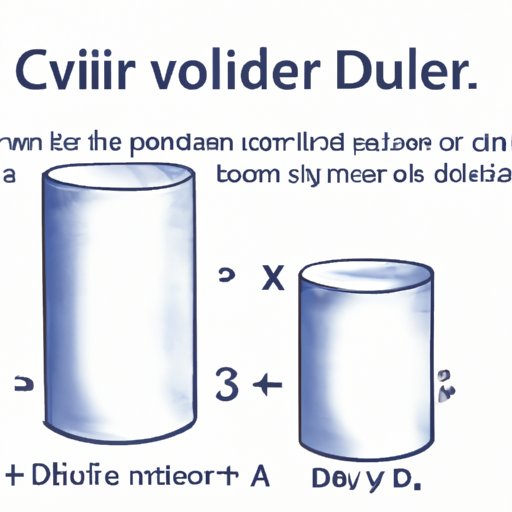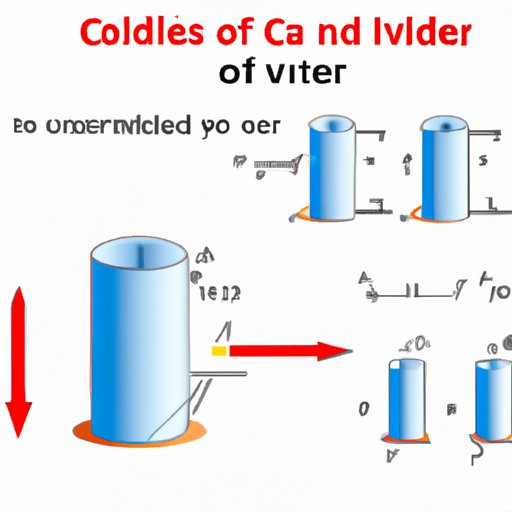
I. Introduction
If you need to calculate the volume of a cylinder, you’ve come to the right place! Whether you’re a student learning geometry or a professional looking to solve a practical problem, knowing how to calculate a cylinder’s volume is an important skill to have. In this article, we’ll explain step-by-step how to calculate the volume of a cylinder, including the formula, an overview of the mathematical concepts involved, and various methods for solving cylinder volume problems.
II. Easy Steps to Calculate the Volume of a Cylinder
Before we dive into the formula and its derivation, let’s start with the basics.
A. Definition of a cylinder
A cylinder is a three-dimensional shape that has two parallel circular bases connected by a curved surface.
B. Formula for calculating cylinder volume
The formula for calculating the volume of a cylinder is V = πr²h, where V is the volume, r is the radius of the circular base, and h is the height (also known as the length or depth) of the cylinder.
C. Explanation of each component of the formula
The volume of a cylinder is calculated by multiplying the area of the base (πr²) by the height of the cylinder (h). The base of a cylinder is a circle, and the area of a circle is calculated using the formula A = πr². When we multiply the area of the circle by the height of the cylinder, we get the volume of the cylinder.
D. Example problems for practice
Example 1: Find the volume of a cylinder with a radius of 4 cm and a height of 10 cm.
Solution:
V = πr²h
V = π(4²)(10)
V = 160π
The volume of the cylinder is 160π cubic centimeters.
Example 2: Find the volume of a cylinder with a radius of 2.5 cm and a height of 7.2 cm.
Solution:
V = πr²h
V = π(2.5²)(7.2)
V = 45π
The volume of the cylinder is 45π cubic centimeters.
III. The Mathematics Behind Cylinder Volume Calculation
In this section, we’ll dive deeper into the mathematics behind the cylinder volume formula.
A. Derivation of the cylinder volume formula
The cylinder volume formula can be derived using calculus. The volume of the cylinder can be seen as the sum of an infinite number of thin circles (or disks) stacked on top of every other. Each disk has a radius of r and a thickness (or height) of dx. By integrating all of these infinitesimal disks, we can calculate the volume of a cylinder.
B. Explanation of the mathematical concepts involved
The cylinder volume formula involves the use of several mathematical concepts, including the area of a circle, integration, and calculus. Calculus is a branch of mathematics that deals with rates of change and accumulation, and it is essential in understanding the volume of a cylinder formula.
C. Overview of the history of cylinder volume calculation
The ancient Egyptians and Greeks were among the first to use cylinder volume calculations to aid in construction projects, particularly with the building of aqueducts and irrigation systems. Since then, cylinder volume calculations have been used in various fields, including architecture, engineering, and manufacturing.

IV. How to Find the Volume of a Cylinder: A Comprehensive Guide
Now that we’ve covered the basics and the mathematics behind cylinder volume calculations let’s explore different methods for solving cylinder volume problems.
A. Various methods of calculating cylinder volume
Here are some methods that you can use to calculate the volume of a cylinder:
- The formula method (πr²h)
- The water displacement method (using a graduated cylinder)
- The geometric method (using different shapes to approximate the volume of a cylinder)
- The calculus method (using integration to derive the volume of a cylinder)
B. Comparison of the methods
Each of these methods has its advantages and disadvantages. The formula method is the most straightforward and widely used method, while the calculus method is the most rigorous but requires advanced knowledge of calculus. The water displacement method and geometric method are less commonly used but offer different approaches to cylinder volume calculation.
C. Advantages and disadvantages of each method
The advantages and disadvantages of each method are as follows:
- Formula method: Easy to use, requires basic math skills, limited to measuring regular cylinders
- Water displacement method: Can be used for irregular cylinders, slow and time-consuming, requires specialized equipment
- Geometric method: Good for approximating the volume of irregular shapes, may require multiple shapes to get an accurate measurement
- Calculus method: Most rigorous and accurate method, requires advanced calculus knowledge, time-consuming
V. Calculating Cylinder Volume Made Simple
It’s essential to have a solid understanding of the formula and methods used to calculate the volume of a cylinder, but there are also some tips and tricks to make the process easier.
A. Tips and tricks for making cylinder volume calculation easier
In addition to the formula, here are some simple tips and tricks to make cylinder volume calculations easier:
- Memorize the formula: Knowing the formula by heart will save you time and make the process faster.
- Use a calculator: Calculators are a great tool for doing complex calculations quickly and accurately.
- Break the problem down: If the cylinder is irregular, try breaking it down into simpler shapes and calculating their volumes separately.
- Check your work: Double-checking your calculations can prevent mistakes and ensure that the answer is correct.
B. Common mistakes and how to avoid them
There are some common mistakes that people make when calculating the volume of a cylinder. Here are a few tips on how to avoid them:
- Forgetting to square the radius: When using the formula, it’s important to square the radius to get an accurate measurement of the base area.
- Mixing up diameter and radius: The radius is half the diameter of a circle, so be sure to use the correct value in the formula.
- Misreading the measurements: Make sure to double-check the measurements and units of the cylinder before calculating its volume.
C. Real-life applications of cylinder volume calculation
Knowing how to calculate the volume of a cylinder has many practical applications, including:
- Calculating the amount of paint needed to paint a cylindrical tank
- Estimating the volume of a swimming pool or water tank
- Determining the amount of liquid medication in a syringe
- Calculating the amount of concrete needed to fill a cylindrical foundation
VI. Mastering Cylinder Volume Calculation in Minutes
If you’re still struggling with cylinder volume calculations, don’t worry – mastering the process only takes a few minutes.
A. Step-by-Step guide to calculations
Here is a step-by-step guide to calculating the volume of a cylinder:
- Measure the height and radius (or diameter) of the cylinder.
- Square the radius and multiply it by π to get the area of the circular base.
- Multiply the area of the base by the height to get the volume of the cylinder.
B. Diagrams and visual aids for understanding the process
Visual aids and diagrams can be helpful in understanding the process of calculating cylinder volume. Here is an example of a diagram that can aid in the process:

VII. From Radius to Volume: How to Calculate the Volume of a Cylinder
The radius of a cylinder is an essential component in calculating its volume.
A. Explanation of how the radius of a cylinder impacts its volume
The radius of a cylinder directly affects the area of its circular base, which is used to calculate the volume of the cylinder. The larger the radius, the greater the area of the base, and therefore the larger the volume of the cylinder.
B. Discussion of how to calculate the radius of a cylinder
The radius of a cylinder can be measured directly using a ruler or tape measure. If the diameter of the cylinder is known, the radius can be calculated by dividing the diameter by 2 (since the radius is half the diameter).
C. Examples of calculating cylinder volume using different radii
Example 1: Find the volume of a cylinder with a radius of 6 cm and a height of 12 cm.
Solution:
V = πr²h
V = π(6²)(12)
V = 432π
The volume of the cylinder is 432π cubic centimeters.
Example 2: Find the volume of a cylinder with a radius of 10 cm and a height of 8 cm.
Solution:
V = πr²h
V = π(10²)(8)
V = 800π
The volume of the cylinder is 800π cubic centimeters.
VIII. Conclusion
A. Recap of the importance of cylinder volume calculation
Knowing how to calculate the volume of a cylinder is an essential skill that has many practical applications in different fields, including engineering, architecture, and science.
B. Summary of the key points covered in the article
In this article, we covered the definition of a cylinder, the formula for calculating cylinder volume, the mathematics behind the formula, various methods for calculating cylinder volume, tips and tricks for making the process easier, and the importance of the radius in cylinder volume calculation.
C. Final words of encouragement and motivation.
Cylinder volume calculation may seem challenging at first, but with practice and a solid understanding of the formula and methods involved, it can become an easy and intuitive process. Don’t be afraid to reach out for help if you encounter any difficulties, and keep practicing until you feel confident in your skills.




